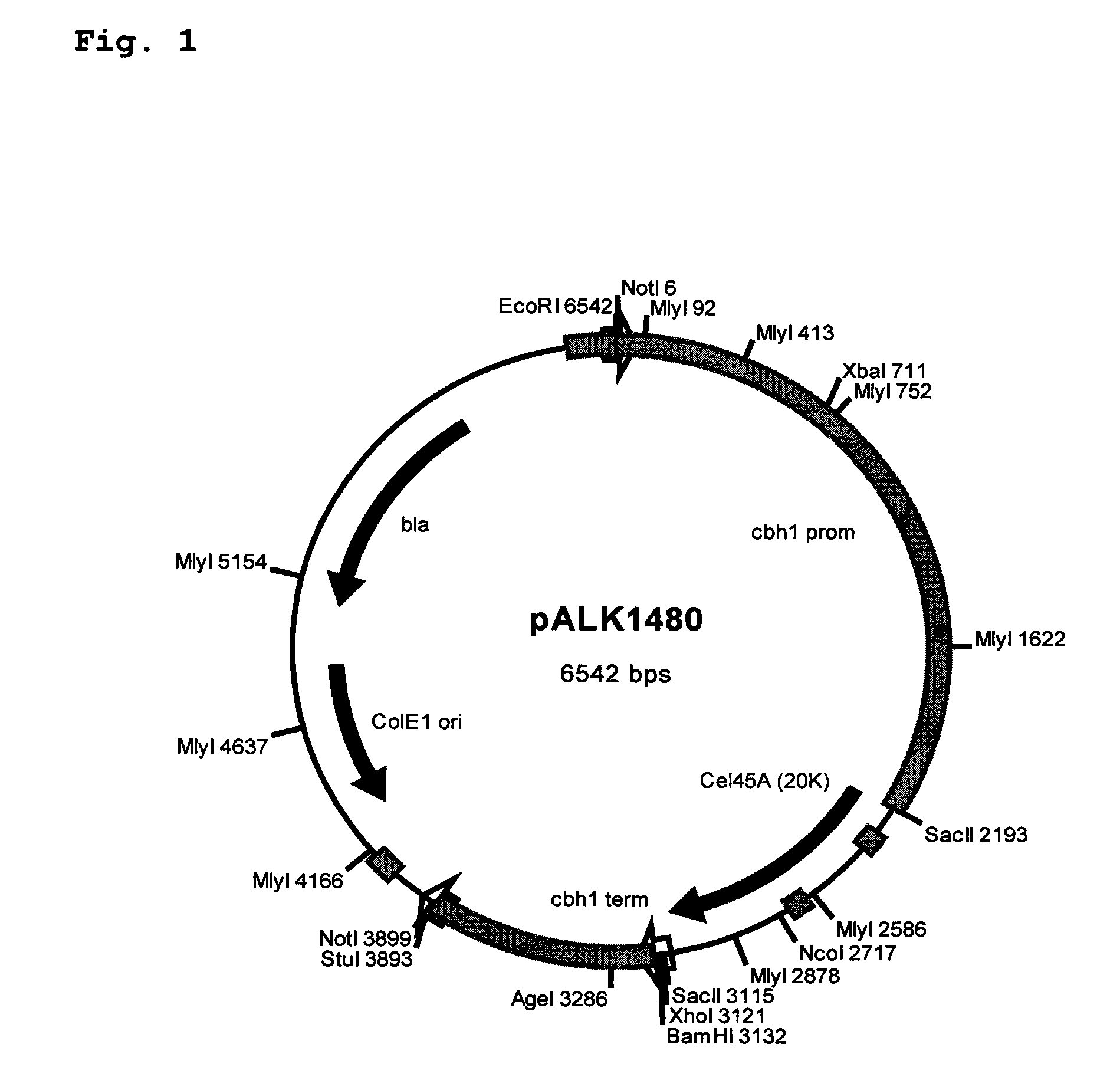Novel Cellulases and Their Uses
a cellulase and cellulase technology, applied in food preparation, biological water/sewage treatment, detergent compounding agents, etc., can solve the problems of reducing the strength of fabric, burdening the laundering apparatus, and affecting the practical use of cellulases, so as to enhance the performance, stability, or buffer the desired enzyme preparation
- Summary
- Abstract
- Description
- Claims
- Application Information
AI Technical Summary
Benefits of technology
Problems solved by technology
Method used
Image
Examples
example 1
Construction of the Expression Vectors for 20K+CBD Fusion Proteins
[0139]Standard molecular biology methods were used in the isolation, purification and enzyme treatments of DNA (plasmids, DNA fragments), in polymerase chain reactions (PCR), in E. coli transformations, etc. The basic methods used are described in the standard molecular biology handbooks, e.g., Sambrook et al. (1989) and Sambrook and Russell (2001).
[0140]Plasmids constructs were designed to join the Melanocarpus albomyces 20K (Cel45A, AC#AJ515703; SEQ ID. NO: 1) coding sequence with the coding sequence of the linker and CBD of the Trichoderma reesei CBHI (AC#AR088330; Srisodsuk et al. 1993; SEQ ID. NO: 3). Altogether six different junctions were designed as described in Table 1.
[0141]For constructs #1 and #2 set forth in Table 1, a unique NruI site was introduced at the end of the 20K coding sequence. This site enables direct fusion after the codon for the serine #213 of the mature 20K with any DNA fragment with a blu...
example 2
Production of the Fusion 20K+CBD Proteins in T. reesei
[0151]8.7 kb linear expression cassettes from the plasmids pALK1434 and pALK1435 were isolated from the vector backbone after EcoRI digestion and transformed to T. reesei A47 protoplasts. The transformations were performed as described in Pentla et al. (1987) with the modifications described in Karhunen et al. (1993) selecting with acetamide as the sole nitrogen source. The transformants were purified on selection plates through single conidia prior to sporulating them on PD (Potato Dextrose Agar).
[0152]The 20K+CBD production of the transformants was analysed from the culture supernatants of the shake flask cultivations (50 ml). The transformants were grown for 7 days in a complex cellulase-inducing medium (Joutsjoki et al. 1993) buffered with 5% KH2PO4 at pH 5.5. The enzyme activity of the fusion protein was measured as the release of reducing sugars from carboxymethylcellulose (3% CMC) at 50° C. in 50 mM Hepes buffer pH 7.0 in...
example 3
Production of the Fusion 20K+CBD Affinity Mutant Proteins in T. reesei
[0159]Melanocarpus albomyces 20K (cel45A, AC#AJ515703) enzyme was fused to the cellulose-binding domain (CBD) of Trichoderma reesei CBHI, in which the conserved tyrosine residues at positions 31 (corresponding to Y492 of the mature polypeptide) and / or 32 (corresponding to Y493 of the mature polypeptide) were mutated to alanine as described by Linder et al., 1995. In addition, the tyrosine residue at position 31 was replaced by tryptophan, an amino acid naturally found in the CBD region of e.g., Humicola grisea CBHI (Azevedo et al., 1990) and T. reesei EGV (Cel45A, Saloheimo et al., 1994). The mutated CBDs were constructed by PCR, and the amino acid substitutions of Y31A, Y32A, Y31W and Y31A_Y32A were included in the cellulose-binding domain of T. reesei CBHI (numbering according to amino acid sequence of CBD). In all constructs, the forward primer 3_BamMly: 5′-TAGGATCCGAGTCCCATTACCGGCAACCCTAGCG-3′ (SEQ ID. NO: 18...
PUM
 Login to View More
Login to View More Abstract
Description
Claims
Application Information
 Login to View More
Login to View More - R&D
- Intellectual Property
- Life Sciences
- Materials
- Tech Scout
- Unparalleled Data Quality
- Higher Quality Content
- 60% Fewer Hallucinations
Browse by: Latest US Patents, China's latest patents, Technical Efficacy Thesaurus, Application Domain, Technology Topic, Popular Technical Reports.
© 2025 PatSnap. All rights reserved.Legal|Privacy policy|Modern Slavery Act Transparency Statement|Sitemap|About US| Contact US: help@patsnap.com



